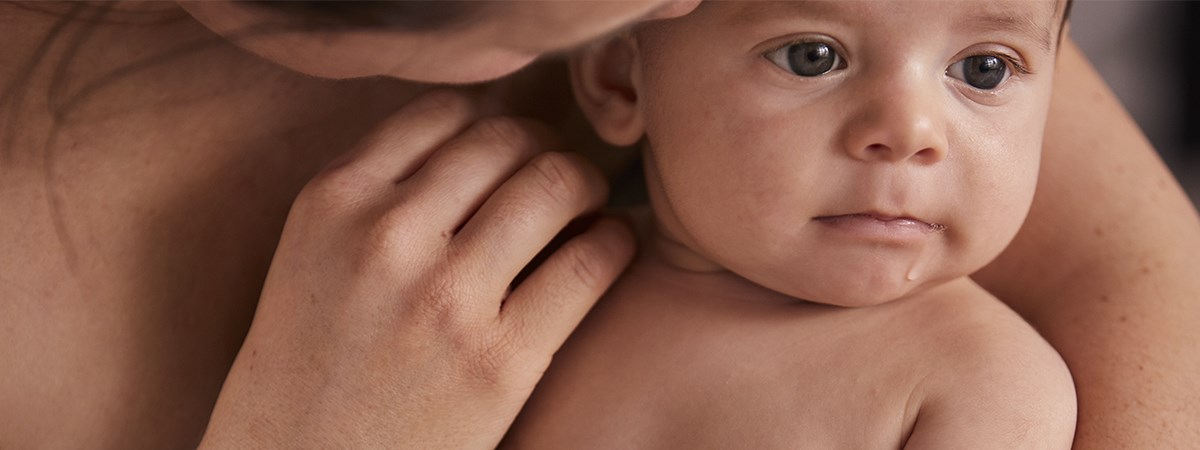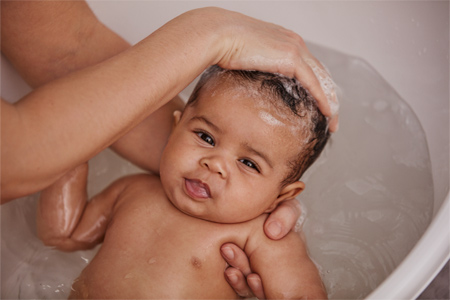How to care for your baby’s skin
Smooth and soft baby skin is one of the best things in the world. But your baby’s skin is delicate and needs protection from things like the sun, moisture and cold. Baby skin can also get dry easily. Read about what to expect when it comes to skincare for babies here.
Our skin is made up of three layers, all with different functions, but unlike the skin of an adult, a baby’s skin is much thinner – and therefore much more sensitive to external factors such as heat, sun, moisture and cold. That’s why it’s good to give your baby’s skin a little extra care.
Dry skin in babies
Lots of newborn babies have dry and slightly scaly/flaky skin, which is completely natural because the skin’s natural secretion of sebum has not really kicked in. It usually settles down a few weeks after the baby is born.
If your baby’s skin is still dry, you can add a few drops of baby oil to the water at bath time. It is also possible to apply a little oil to your baby’s skin straight after the bath, preferably when the skin is still moist so that the oil is absorbed more easily. As babies’ skin is more sensitive than adults’, remember to use unscented products that are suitable for little ones – check with your healthcare provider if the cream, lotion or oil you have chosen is suitable for thin baby skin. If you are unsure, you can also ask them to take a closer look at your baby’s skin to confirm that everything is fine. Babies with eczema and/or very dry skin usually benefit from not bathing too often, as water dries out the skin.
Bumpy skin in babies
Bumpy skin on a baby’s face is very common in newborn babies. It’s a kind of hormonal acne which will disappear on its own within a few weeks – without the need for any treatment. However, if it does not disappear, it may be that your baby has an allergy or is sensitive to something. Atopic eczema can also show up as red and bumpy skin on the face of young babies. Talk to your healthcare provider if the bumps don’t go away.
Try to avoid moisture and heat on your baby’s skin
Moisture and heat – especially in combination – are not good for a baby’s skin. Make sure you use a breathable nappy and leave your baby without a nappy for a while during each nappy change to reduce the risk of a red and irritated bottom when you take the nappy off next time.
Both babies and young children are also prone to heat rashes, often during the summer when temperatures rise, but they can also appear during the winter months if the baby has been dressed too warmly. Heat rash is not dangerous, but you can help speed up recovery by cooling your baby down, for example by changing them into thinner, more breathable clothing. Small babies can’t tell you if they feel too hot or cold, and they also have difficulty regulating their own body temperature. In fact, one great way to help the very young is through skin-to-skin contact, which helps babies maintain their body temperature.
Protecting your baby’s skin from the sun, wind and cold
The best way to protect your baby’s skin from the sun is to stick to the shade. Babies under one year old should ideally not be in the sun at all if it can be avoided. But even wind and cold can be hard on little baby cheeks. You may want to consider not washing your baby’s face on the same day you’re going out in the cold, as this will remove the natural protective oils in your baby’s skin. And if you want to moisturise your baby’s skin, it’s a good idea to choose a cream that doesn’t contain water, as this can make little faces even more vulnerable. If it is very windy and cold, it is also wise to stay indoors if you have a small baby. The wind has a major impact on how cold it feels, and a 10m/s wind can make it feel twice as cold as what it says on the thermometer.
Rashes and eczema in babies and young children
Rashes, eczema and various types of skin irritation can be caused by a variety of things, such as hormones, illnesses, genetics or just external factors such as heat and humidity. To learn more about babies’ delicate skin, read our guide on the different types of rashes and spots that are common in babies, what causes them, what the symptoms are and how to treat them.
Want to learn even more about baby skin? Check out Libero’s skin school – where we have compiled our skincare advice for little ones.
Please note that all information above is based on Swedish recommendations.



